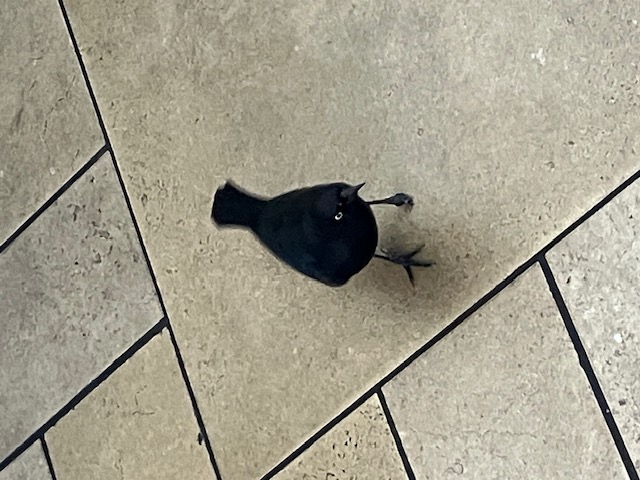
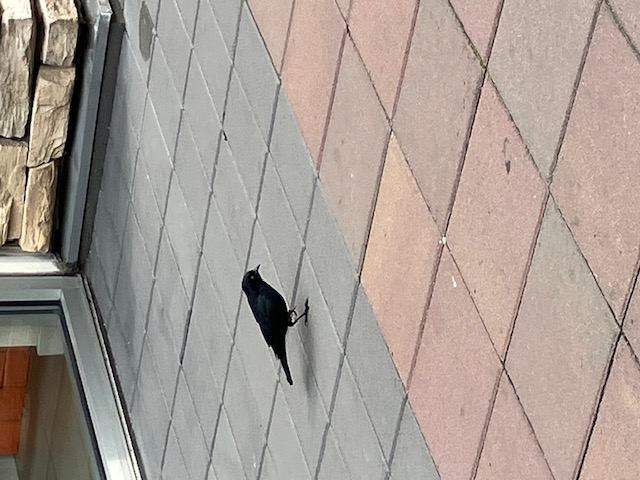
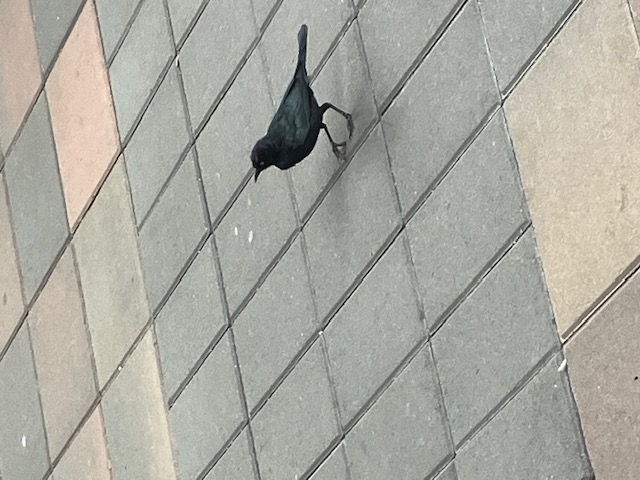
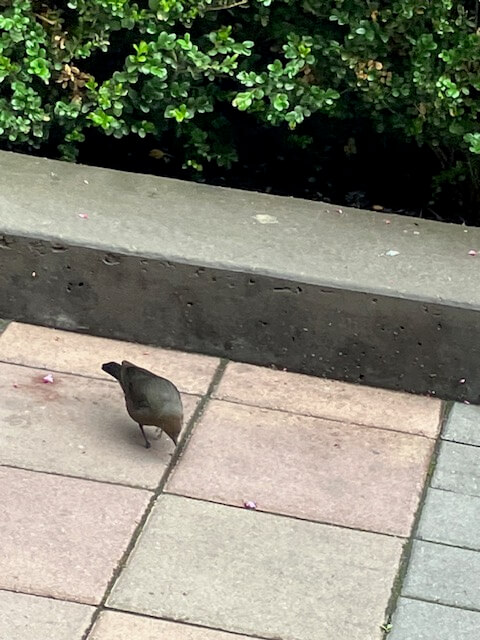
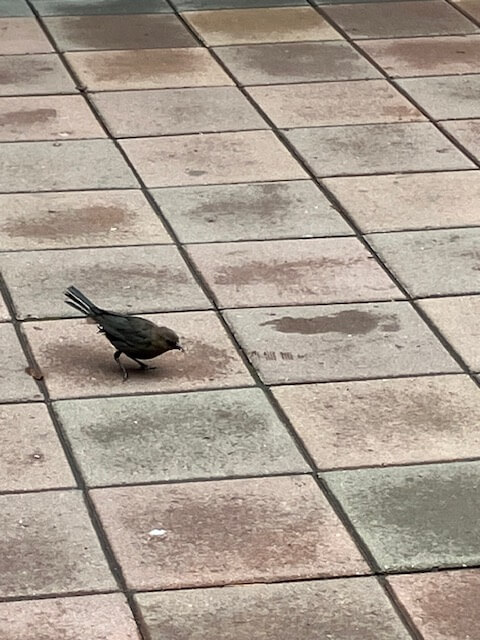
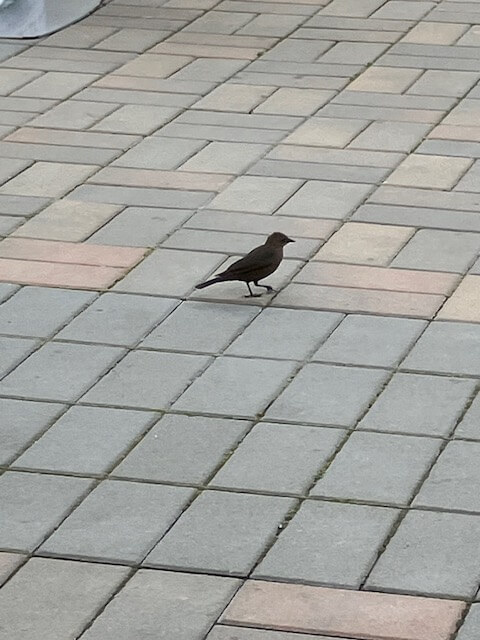
For a while I’ve been interested in the birds that live around the mall I work at. When you bother to pay them individual attention, I quickly found that many of them seemed either injured or disabled.
Honestly, I feel multiple ways about it – like, on the one hand, it’s always nice to see disability in other species. Eugenics has many a culture in its grip, and many people, without thinking, make the assumption that disability is never tolerated outside human charity, or don’t even consider that it could exist, and that visible contradiction feels kind, and valuable. But also – is there something about the mall, as a human-made structure, that is facilitating physically disabling them? Are they just injured and I just looooooove reading into things? Is this typical among those species anyways, like are they just performing behaviors I don’t recognize as normal because I don’t know enough about them? But I love them anyways, I want to get to know them more.
It’s mostly blackbirds at the mall, but none of the pictured birds are redwings!
It’s interesting to see how they interact... Sometimes they just lay on the ground and don’t move even when you get close. They fly up the high roofs and the insides of the food court's high ceiling and the outdoor coverings, and I wonder if they nest there – it’s safe from rain, what little of it we get, and I would presume safe from local predators – it’s out of reach for humans, and I haven’t noticed another animal that would seem to predate them, outside of if there’s, like, parasites or bugs that get them or something.
Also, I noticed recently that there's fucking anti-bird spikes on the outdoor coverings, which like, go to hell, oh my fucking god, boo hoo you have to pay someone to clean it, get the fuck over yourselves, you stupid greedy bastards. The birds flew just behind or in between the spikes anyways, so fuck you extra, those that inhabit an environment will always adapt to it and survive. But fuck you for trying to make that harder, instead of just figuring out a way you could both live together.
It's been a few months since I've made this page, and the original statements presented... while I value the instincts they display, I've since learned, what I believe, to be the reason so many birds look like this -- it's just stringfoot. For the uninitiated, stringfoot is a common phenomena amongst birds that live around people and walk on the ground. Their toes will get tangled up in predominately human hairs, but also other loose threads and strings on the ground, and over time will accumulate, tighten, and slowly cut off circulation until the toe eventually falls off, leading to birds lacking toes or even dropping off all toes on a foot. You can see this with the first bird on this page, "Blinkie." Furthering this idea is that I've seen a bird with a mass of hairs and strings around a foot walk near me during one of my lunch breaks.
There are people who attempt to help birds with stringfoot by destringing before it fully cuts off circulation as well. There is a well known group near me I'd like to join but they're only on Facebook and......... I did delete that and I'm not making an account just for that, unfortunately.
Brewer’s blackbird (Euphagus cyanocephalus)
Brewer's Blackbirds live throughout much of North America, and much of the non-New England states in the US! They have a more year-round presence in the western states, and a more migratory presence in the others. These birds display sexual dimorphism Different sexes of the same species having different traits, such as size or coloration, with males having black feathers and yellow eyes and females having brown feathers and black eyes.
Brewer’s Blackbirds will mostly eat seeds and insects – they will happily eat worms or bugs in the summer when they tend to be more abundant, and will search them out to feed their chicks during breeding season, but will otherwise eat seeds, especially in winter. They are ground foragers who, where they live amongst spaces people gather and eat, will also eat any leftover food – I’ve seen them get quite comfortable laying on the ground right next to a table with a family actively eating!
They will separate after mating, but are known to mate with the same partner year after year if their partner is still around. They nest in colonies of up to 100 birds, where the first females will find their ideal nesting locations and the other birds will nest in similar places nearby. Often Brewer’s Blackbirds will nest in shrubs, trees, or other high up locations: I believe some may be nesting on the roof about the food court, potentially in the high ceiling alcoves in the food court, and under the outdoor coverings, though I am not sure how the anti-bird spikes there affects this.
It has been suggested that the color of their nests may often match the color of their eggs for the protection of these eggs, but I do not know how certain this is, as a layperson. Chicks hatch with their eyes closed and a few wisps of grey feathers.
They are currently not deemed to be at risk, however their populations have been declining markedly, with a 57% drop from 1967 to 2019 calculated by the North American Breeding Bird Survey. Some of this can be attributed to poisonings, shootings, and trappings by farmers.





